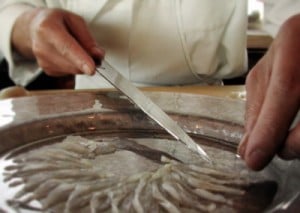Pufferfish - A Tasty Risk
What is This Dish?

While the meat itself is not innately poisonous, some parts (particularly the liver, gonads, intestines, and skin) contain lethal amounts of a potent neurotoxin called tetrodotoxin. This may contaminate the meat if the fish is not prepared by a chef skilled in the art of fugu preparation. Death is not an uncommon result for those who accidentally consume the toxin, for which there is no antidote.
Preparing The Fish
Fugu is a delicacy which only licensed chefs are allowed to prepare in Japan. An approximately three year apprenticeship is required before a chef is allowed to take the examination to ensure they have the proper skills to prepare the dish safely. Approximately 70% of the applicants fail their examination, which is quite complicated. However, this ensures that only the most skilled and knowledgeable of applicants become certified for the task.
The dish is somewhat expensive, with servings in the range of USD $20 to USD $50 and a full course meal costing up to USD $200. Due to the specialty nature of the dish, a chef is careful to prepare the fish gathering the most meat possible, and a special knife called a fugu hiki is employed for the task.
The fish is usually served as sashimi, called fugu-sashi, or tessa, to showcase its delicate texture and unique flavor, and is sliced thinly and placed so that the pattern of the plate is visible through the fish. Given its preparation risks, it’s usually served in specialized restaurants.
The organs are sometimes available as fugu no shirako, however they are specially treated to remove the toxins and are not commonly available.
How Careful Do I Have To Be?
The poisonous nature of the dish comes from marine microorganisms that produce the neurotoxin, which travels up to food chain, eventually finding its way into the puffer fish. While the fish is itself immune to the toxin, it nevertheless concentrates the compound in its organs and skin, much to the chagrin of would-be predators, or sushi enthusiasts.
It is reported that the tiny amount of toxin that finds its way into the meat of the fish slightly numbs the lips and mouth during the meal. This is enjoyable to some, and people even claim feeling a mild state of euphoria at times from eating the dish, though that is not necessarily common. It is also not a specific reason for eating it, but a pleasant side-affect for some. A tingling sensation in the body is often reported by those who east the fish, as microscopic amounts of the chemical are still present at safe levels when prepared properly.
An element of risk may also heighten the experience, as even a minor mistake on the part of the chef may easily kill a diner. In Japan, a number of individuals die each year from fugu poisoning due to incorrectly prepared fugu, usually by amateurs.
On a side note, it is now believed that this particular toxin is used in the Caribbean by Voodoo practitioners in the creation of their supposed “zombie powder,” as just the right dose may induce a paralytic state resembling death, which will last for hours or days. And dolphin have been seen using the fish for its euphoric effect on them.
Is This Kind Of Sushi Now A Safe Bet?
Fugu can be found in many places found as sushi and sashimi, while the fins and skin are also served in a myriad of ways alongside the main dish. Due to the demand, there is now a significant rise in farm-raised pufferfish, which lacks any traces of the tetrodotoxin, and therefore any risk to the consumer.
As fugu is a relatively mild tasting dish, without the element of risk, some question why a person would bother spending the tidy sum to order the dish when there is a lot more on the menu that may be more flavorful. That, however, is a choice for the individual.
I have always been fascinated by the creation and culture of different foods, particularly sushi and sashimi in the modern era of Japanese cuisine. I am a classically trained chef and sushi connoisseur, also having operated a food service company and enjoy investigating and experimenting with food around the world.